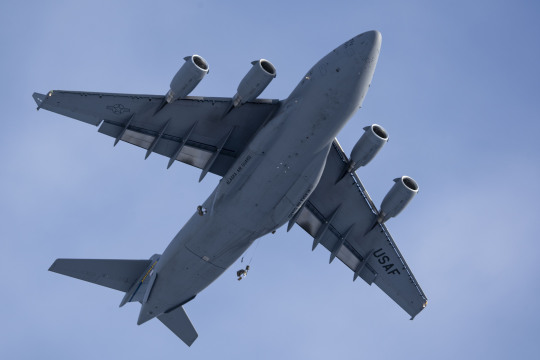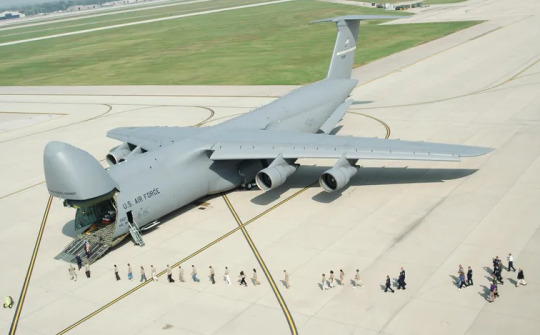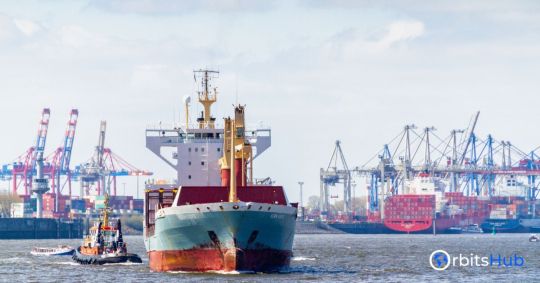#cargo aircraft
Text

USMC Boeing CH-46A Sea Knight parked at MCAS Tustin, California- 18 March 1966
#USMC#Boeing#Vertol#CH-46#Sea Knight#Troop transport#cargo aircraft#Helicopter#rotorcraft#Military aviation#Marine Corps#Helo#Phrog
74 notes
·
View notes
Photo

Douglas C-47 'Raisin-Bombers'. Being unloaded at Berlin Tempelhof Airport during the Soviet Blockade of 1948-49. Berlin Airlift
83 notes
·
View notes
Text
i can't help but feel like the lockheed c-5 galaxy would be a very good pet if it was rather small
like if it was the size of a keyboard it would like being stroked
7 notes
·
View notes
Text

C-17 Globemaster III
5 notes
·
View notes
Text
C-5 Galaxy – The Big Daddy | PlaneHistoria

If you are looking for a large transport aircraft with military-grade capabilities, the C-5 Galaxy is giant of the skies is the largest aircraft in the US Air Force's inventory and is capable of carrying up to 270,000 pounds of cargo. The C-5 is powered by four turbo fan engines, which provide a total thrust of over 200,000 pounds, allowing it to reach a top speed of nearly 600 mph. Its size and power make it ideal for transporting large military payloads, such as helicopters, vehicles, and personnel. The C-5 Galaxy is also used for humanitarian and disaster relief operations. It's the perfect plane for getting aid to those in needs, and its massive cargo bay can quickly and efficiently move supplies to those who need them most. The C-5 Galaxy is the big daddy of transport aircraft. With its massive cargo capacity, high speed, and long range, it's sure to get the job done. Visit our website to know more information.
#military history#military#cold war#world war2#history of aircraft#aircrafts#cargo aircraft#C-5 Galaxy#educacion
19 notes
·
View notes
Text
Get Cheapest courier company in Delhi | Indify logistics.
Indify logistics Company in Delhi, Cheapest Courier Company in Delhi,The Delhi logistic company provides services to both business and residential areas. If you want to filter your things in a secure and efficient manner, using logistic services is the best option. Choose the best logistics company that meets your aims and budget among the numerous available today. We are among the best logistics firms in Delhi. We offer some effective logistic services to Delhi residents as well as business owners.
Affordable logistics Service.
Indify logistics Cheapest Courier service in Delhi.Our logistics services in Delhi are only provided at reasonable rates to suit any budget. Our logistics firm works with skilled and qualified professionals who can deliver the items on time and to the right place. We only provide our valued customers reliable logistical services that are reasonably priced. We reduce the amount of time and money that your company must invest in product delivery. Our carriers provide a variety of supply chain and logistic management options. We provide cutting-edge solutions along with the best people, equipment, and procedures to increase the value of your company.
Advantages.
well regarded logistics partner with over in India
A reliable logistic partner
Booking and on-time delivery at your fingertips
a track record of providing dependable, high-quality logistics services
Our Services
COURIER & CARGO SERVICES
REVERSE LOGISTICS
E-COMMERCE
WAREHOUSING
CONTRACT LOGISTICS
LEAD LOGISTICS
Contact Us.
Website :- www.indify.in
Email Id :- [email protected]
Phone No :- 9821984141
#logistics#courier#cargoservices#cargo transport#cargo aircraft#indify#reverse logistics market#lead logistics#contract logistics#delhi#india
2 notes
·
View notes
Text
Technical consultancy for Aircraft in Portugal
RPEM - Technical Consultancy for Civil Aviation Worldwide- Portugal offers expert technical consultancy services for aircraft operations in Portugal. Our comprehensive support encompasses regulatory compliance, safety standards, maintenance optimization, and operational efficiency enhancement. With a dedicated focus on the intricacies of the Portuguese aviation landscape, we provide bespoke solutions to meet the unique needs of aircraft operators, ensuring smooth and compliant operations. Contact Now!
1 note
·
View note
Text
No you can’t carry a WHALE in a cargo plane.
They’re much too big.
It would also be needlessly cruel.
As for a Klingon starship, we’ll, you’d need to make room but otherwise it can be done.
Theoretically!
#dougie rambles#personal stuff#my poor attempt at a joke#whales#aviation#cargo aircraft#cetaceans#maritime shit#unreality#what#no context#this sounded funnier in my head#star trek#klingon#spaceships#star trek iv: the voyage home
1 note
·
View note
Text
Navigating the Seas and Skies: Marine Services and Air Cargo's Symbiotic Relationship

Introduction
The effective transfer of commodities and resources has evolved into a crucial aspect of contemporary civilization in a world characterized by globalization and interconnection. Marine services and air cargo are two of the main participants in this industry. While at first glance they might appear to be separate fields, deeper examination reveals a strong connection that propels global trade and business. The cooperation between maritime and aviation services creates a complex network that supports worldwide logistics, from the delivery of aircraft parts to the exchange of valuable cargo.
The Vital Function of Marine Services
Marine services are the backbone of global trade because they make it possible for cargo ships to transport commodities over great distances. These vessels transport everything from consumer goods to raw resources, acting as floating warehouses. Since the oceans make up more than 70% of the earth's surface, cargo ships must sail complicated routes to link far-off shores, facilitating the interchange of goods on a global scale.
Marine services can include marine traffic management, a system that makes sure that ships can navigate safely and effectively. Ships can be tracked in real-time, optimizing itineraries and avoiding collisions, thanks to innovative technologies like satellite-based tracking systems. This degree of accuracy is necessary to maintain the flow of commodities and avoid supply chain disruptions.
The best timing and routes for cargo ships to depart are also heavily influenced by marine weather forecasts. Shipping businesses can make decisions that protect both their vessels and the cargo they transport by using accurate forecasts of the sea state and impending storms. In this approach, maritime services considerably increase the trustworthiness of international trade.
Air Cargo: Increasing the Supply Chain's Speed
Air cargo leads in terms of speed and urgency, whereas cargo ships handle bulk transit. The desire for prompt delivery of expensive products such perishable foods, medical supplies, and aircraft parts has fueled the expansion of air freight services. Specifically built for carrying freight, cargo planes are able to transport huge cargoes over long distances in a fraction of the time it would take by ship.

To reduce downtime for repairs and maintenance, aircraft parts, which are essential components in the aviation sector, frequently need to be delivered right away. The aviation industry can maintain smooth operations because to air cargo's capacity to quickly carry these components to their required locations. Air cargo makes sure that essential components, whether they be crucial aircraft engines or specialized equipment, arrive at their destinations quickly, minimizing operating delays.
Synthesis at Work
Air cargo and marine services have a complementary rather than merely antagonistic relationship. Imagine that a multinational company needs to ship aircraft parts to a far-off location. Although quick delivery of the parts might be guaranteed via air cargo tracking, the accompanying expenses might be too high. The maritime industry fills this role. In order to strike a balance between speed and cost-effectiveness, large amounts of less urgent components can be transported by cargo ships, while the more vital components are delivered by air.
Additionally, the partnership goes beyond actual transportation. Similar to those used in marine traffic management, air cargo monitoring systems offer real-time information on the whereabouts of cargo flights. This tracking capability improves transparency and allows businesses to keep an eye on and make necessary adjustments to their supply chain processes. Alternative plans might be made in the event that a cargo aircraft has unanticipated delays to guarantee the prompt delivery of products.
Marine and aviation fuel: feeding the Nexus
Air cargo and maritime industries both rely substantially on fuel to run their operations. To move container ships across seas, the maritime sector needs enormous amounts of marine petroleum, which accounts for a sizeable share of the world's fuel consumption. On the other side, aviation fuel maintains cargo planes in the air, ensuring quick delivery of cargo to its destination.
Innovations in fuel efficiency and alternative energy sources are vital for both industries as the world turns its attention to sustainable practices. The aviation sector invests in research to make air travel more environmentally friendly, while the maritime sector investigates cleaner propulsion systems and fuel alternatives. Both industries' parallel efforts to be sustainable demonstrate their dedication to reducing their negative effects on the environment.
Conclusion
Our integrated global economy is built on the dynamic interaction between marine services and air freight. These two fields work together flawlessly to ensure the quick movement of commodities across great distances, from the transportation of aircraft types to the exchange of precious cargo. The effectiveness and dependability of these services are improved by the development of technology like aviation cargo tracking and marine traffic management.
The difficulty comes from trying to achieve sustainability while preserving this delicate balance as we move forward. The maritime and aviation sectors must keep on innovating to find ways to lower their environmental impact and their carbon footprint. We can ensure the smooth circulation of products while conserving the health of our planet for future generations by nurturing this symbiotic relationship and adopting ethical practices.
#Marine service#air cargo#Aircraft Parts#maritime#cargo aircraft#Air cargo tracking#Aircraft engine#Cargo ship#satellite phone#aviation fuel#Marine traffic#marine weather forecast
1 note
·
View note
Text
Marine and air cargo services converge to improve global trade

Introduction:
Effective transportation infrastructures are crucial for the efficient movement of goods and services in a connected society driven by global trade. The maritime and aviation industries are two important areas that are crucial in this regard. Air cargo has emerged as a quick and dependable means of transportation, whereas marine services have long been a foundation of international trade. In this blog article, we'll look at how technical improvements and creative solutions have helped the fusion of maritime and air cargo services transform the logistics industry.
Marine Services: A Global Trade Anchor
A wide range of operations connected to the transportation of goods and services through waterways are included in marine services. Cargo ships, which frequently transport enormous loads, are the foundation of global commerce. Raw resources, finished goods, and even specialty cargo like hazardous materials are being transported by these vessels. In order to provide safe and effective transportation throughout the oceans, marine services also perform vital support roles like monitoring marine traffic and forecasting marine weather.
Speeding Up Global Logistics Using Air Cargo
Air cargo delivers unmatched speed and efficiency compared to maritime carriers, enabling time-sensitive deliveries across great distances. Cargo aircraft are being used more frequently to transport a wider variety of goods, such as perishable goods, medications, and expensive goods. Systems for tracking air cargo have advanced as well, enabling shippers and recipients to follow the exact location of their shipments in real time. Furthermore, the effectiveness of global supply chains has been substantially aided by the aviation industry's capacity to carry vital components like engine parts and aircraft parts.
Leveraging Technology and Collaboration: The Synergy
Technology developments and improved cooperation between the maritime and aviation industries have made it possible for marine and cargo aircraft services to converge. One such innovation is satellite communication, which permits seamless connectivity across extremely long distances and ensures effective coordination between cargo ships and aircraft. Professionals in the maritime and aviation industries now depend on satellite phones to successfully communicate in distant locations where access to regular communication networks may be constrained.

Furthermore, the intermodal connectivity between marine service and air freight services has strengthened with the use of shared infrastructure, such as airports close to significant seaports. Through this connectivity, it is possible to shift cargo quickly from ships to airplanes or vice versa, cutting down on transit times and increasing overall effectiveness.
Aviation Fuel and Environmental Concerns: Fueling the Convergence
While there are many advantages to the combination of marine and air freight services, there are also some environmental problems, notably with relation to the use of aviation fuel. The sector needs to concentrate on sustainable solutions as demand for air freight rises. The carbon footprint of cargo shipment is being reduced through efforts to find other fuels and enhance fuel economy. More fuel-efficient engines have also been created as a result of technological breakthroughs, further enhancing environmental sustainability.
Consequently, faster, more dependable, and effective transportation of goods and services is now possible because to the convergence of marine and air cargo tracking services. This convergence has improved overall logistics operations by streamlining supply chains and encouraging collaboration between the maritime and aviation sectors. This convergence must, however, prioritize environmental concerns, which calls for ongoing initiatives to reduce the carbon footprint associated with air freight.
As we look to the future, technological developments, increasing sustainability measures, and the expanding demands of global trade will all drive further evolution in the integration of maritime and air cargo boat services. The logistics sector can create a more durable and robust infrastructure that will serve the rising demands of international trade by embracing innovation and placing a high priority on environmental stewardship.
#Marine service#air cargo#Aircraft Parts#maritime#cargo aircraft#Air cargo tracking#Aircraft engine#Cargo ship#satellite phone#aviation fuel#Marine traffic#marine weather forecast
0 notes
Text

"Exfil Exercise"
#USMC#Sikorsky#CH-53#Super Stallion#CH-53E#Marine Corps#Military aviation#Helicopter#Cargo aircraft#transport aircraft#Heavy lift Helicopter#Helo
79 notes
·
View notes
Text
The Critical Role of Marine and Air Cargo Services in Navigating the Seas and Skies

Introduction
The effective movement of commodities is essential for international trade and economic expansion in the connected world of today. Marine services and air freight, which offer the capacity to carry enormous quantities of products across great distances, are two important pillars of the logistics sector. This blog examines the value of air and maritime cargo services, demonstrating how crucial they are to the movement of commodities and the health of many businesses. We will also explore the key elements that enable these services, such as satellite phones, aviation fuel, maritime traffic, air cargo tracking, aircraft engines, cargo ships, and aircraft parts and maritime vessel tracking.
Continent Connections through Marine Services
The ability to transfer commodities between continents is made possible through maritime transportation, which is essential to international trade. The mainstay of marine services, cargo ships are capable of transporting enormous volumes of cargo, including consumer products, vehicles, and raw materials. These ships travel the oceans of the world, linking important ports and promoting global trade.
The tracking of cargo is an essential component of marine services. Shippers and logistics service providers can follow the position and condition of their cargo in real-time with the aid of cutting-edge technology, such as satellite-based tracking systems. This improves operational effectiveness while also guaranteeing the safety and prompt delivery of goods.
Air Cargo: Boosting International Trade
Air cargo is crucial for time-sensitive shipments because it offers unsurpassed speed and efficiency while maritime services excel at moving big amounts of cargo. Even the most remote parts of the world can be reached quickly by cargo aircraft because they are outfitted with specialized equipment. Air cargo services deliver them with the highest urgency, whether they are high-value items, medical supplies, or perishable goods.
Engines and aircraft parts are essential to aviation.
Aerial cargo services depend on aircraft parts and engines to be dependable and safe. To guarantee their peak operation, these sophisticated devices go through thorough maintenance and inspection. Suppliers of aircraft parts are essential in delivering the parts required for upgrades, replacements, and repairs. These components maintain the best possible operational state for cargo aircraft's engines, landing gear, and avionics systems.
Satellite phones and Air Cargo Tracking: Ensuring Communication and Security
To maintain security and control during the shipping process, the logistics sector significantly relies on air cargo tracking systems. The position, temperature, and other crucial factors of the shipment are all tracked by real-time tracking systems. This enables shippers and logistics service providers to carefully monitor the movement of products, swiftly resolve any problems, and give consumers precise delivery estimates.
Additionally, satellite phones are essential for communication in remote locations where conventional methods might not be dependable. Satellite phones provide as a lifeline in emergency situations or unforeseen circumstances, allowing ongoing communication between pilots, ground workers, and shipping personnel. The possibility for disruptions to air freight operations is reduced because to these communication systems' quick responses and effective coordination.
The Lifeblood of Air Cargo: Aviation Fuel
Jet fuel, also referred to as aviation fuel, drives cargo planes and maintains the flow of goods throughout the world. In order to maintain ongoing operations, the logistics sector is significantly dependent on a steady supply of aviation fuel. In recent years, concerns about sustainability and fuel economy have grown significantly, prompting the creation of more environmentally friendly substitutes. The goal of ongoing developments in fuel technology is to lessen the environmental impact of the industry and the carbon footprint of air freight services.
Marine Traffic's Contribution to Safe Passage
Marine traffic management has grown crucial due to the rise in the number of cargo ships traveling the oceans. AIS, automated identification systems (AIS), and coastal radar networks allow maritime authorities to detect ship movements, avert collisions, and guarantee safe passage. Systems for managing marine traffic aid in route optimization, ease traffic on congested waterways, and guarantee the prompt delivery of commodities to their final locations.
Conclusion
Services for cargo shipment cargo by air and sea are essential for expanding trade and the global economy. These services are crucial to the logistics sector because they enable the movement of goods across great distances, bridging continents, and accelerating the supply chain. These services remain functional and effective because to the interaction of many different pieces, including aircraft parts, aircraft engines, air freight tracking systems, maritime boats, satellite phones, and aviation fuel. The sea and air cargo industries will develop further as technology advances, enabling faster, safer, and more environmentally friendly global movement of commodities.
#Marine service#air cargo#Aircraft Parts#maritime#cargo aircraft#Air cargo tracking#Aircraft engine#Cargo ship#satellite phone#aviation fuel#Marine traffic
0 notes
Text
The Intersection of Marine Service and Air Cargo is Revolutionizing Logistics

Introduction:
The effective movement of commodities across great distances has long been a priority in the dynamic world of logistics. The marine industry has long been an important actor in global trade, while air freight has grown in popularity due to its speed and dependability. However, the merger of these two businesses has created new opportunities for seamless transportation. In this blog post, we'll look at the symbiotic link between marine service and air cargo, emphasizing the importance of aircraft hangars, air cargo tracking, aircraft engines, cargo ships, and satellite phones in transforming the logistics landscape.
Aircraft Hangars Improve Air Cargo Operations
Aircraft hangars are critical pieces of infrastructure for air cargo operations. These massive structures provide cargo aircraft with cover, maintenance, and repair facilities. Aircraft hangars facilitate the efficient flow of products by preserving the structural integrity of planes and protecting them from harsh weather conditions. These hangars, with their innovative technology and roomy interiors, contribute to faster turnaround times and improved cargo capacity, improving the overall effectiveness of air cargo operations.
Transparency and Security in Air Cargo Tracking
In the logistics business, real-time tracking of aviation freight has become critical. It enables shippers, consignees, and logistics providers to track the location and condition of items throughout the shipping process. Stakeholders can properly forecast delivery schedules, prevent theft or tampering, and solve any operational difficulties that may develop by integrating tracking technology like as GPS and RFID. Air cargo tracking improves openness while also ensuring the safety of valuable and time-sensitive shipments.
The Logistics Ecosystem is Powered by Aircraft Engines
Cargo airplane engines play an important part in the logistics ecosystem. These strong devices provide the push required to move huge objects quickly and efficiently. Constant advances in aviation engine technology have resulted in improved fuel efficiency, lower emissions, and longer flight ranges. Longer flights, shorter delivery times, and improved operational flexibility have all been made possible by the development of more reliable and high-performance engines.
Cargo Ships: The Maritime Trade's Backbone
While air freight provides speed, the maritime industry remains the backbone of global trade due to its ability to handle large amounts of products. Cargo ships transport a diverse range of goods across the world's oceans, providing cost-effective and dependable transportation options. These ships are built to carry a wide range of cargo, including bulk commodities, containerized items, and large packages. Cargo ships supplement air cargo services by utilizing the extensive network of ports and waterways, allowing for seamless multimodal transportation.
Satellite Phones: Communicating in Remote Locations
Communication is critical for coordination, safety, and efficiency in marine and air freight operations. Many places, however, lack dependable terrestrial communication infrastructure. Satellite phones become crucial instruments in such situations for keeping ongoing connectivity. Crew members, logistics operators, and other stakeholders can communicate regardless of their location, ensuring seamless coordination, emergency response, and operational efficiency, especially in remote places or during transoceanic flights.
Conclusion:
The seamless integration of maritime and air cargo services has transformed the logistics business, boosting global trade to new heights. Aircraft hangars, air freight tracking, aircraft engines, cargo ships, and satellite phones are all essential parts of this transformational process. Logistics providers may optimize transportation routes, improve delivery times, and increase customer satisfaction by harnessing the assets of both industries. As technology advances, we may expect further innovations that will revolutionize how things are delivered around the world, resulting in a more connected and efficient logistics ecosystem.
#Marine service#air cargo#aircraft hangars#maritime#cargo aircraft#Air cargo tracking#Aircraft engine#Cargo ship#satellite phone
0 notes
Text
General Dynamics F-16 – The Rebirth of the Dogfighter | PlaneHistoria

Do you know at the end of the Cold War, the US Air Force was in search of a new fighter jet? Enter the General Dynamics F-16. This new aircraft marked a rebirth of the classic American dogfighter. The F-16 was designed to be an agile and maneuverable aircraft that could outthink and outmaneuver its opponents. The aircraft was built with a lightweight airframe and advanced avionics, giving it an edge in air-to-air combat. It was also designed to be versatile, able to carry a variety of weapons and sensors. The F-16 was an instant hit with pilots, who praised its agility and ability to execute complex maneuvers.
The General Dynamics F-16 was also designed to be cost-effective. The aircraft was designed to be easy to maintain and could be flown by a single pilot. This efficiency allowed the F-16 to be deployed to multiple theaters of operation, including the Persian Gulf War, the Kosovo War, and the Afghanistan War. The F-16 has been used by the US Air Force, as well as by other countries around the world. The F-16 has proven itself to be an effective and reliable aircraft, and its popularity continues to grow.
The General Dynamics F-16 has been an integral part of the US Air Force’s arsenal. It is a versatile aircraft that can be used in a variety of roles, from air-to-air combat to ground attack missions. The aircraft has seen action in multiple conflicts, proving its effectiveness and reliability. The F-16 is a testament to the power of American innovation and engineering, and it has earned its place as one of the most iconic aircraft of the modern age. The General Dynamics F-16 will continue to be a staple of the US Air Force for years to come. Visit our website to know more information.
#General Dynamics F-16#C-5 Galaxy#Lockheed SR-71 Blackbird#Sukhoi Su-34 Fullback#SEPECAT Jaguar#Focke-Wulf Fw-190#Grumman F-14 Tomcat#SR-71 Ichi-Ban#Air Force Buried#Military#world war1#world war2#education#history#news#wwii aircraft#cargo aircraft#aircrafts#history of aircraft#cold war
9 notes
·
View notes
Text
The Intersection of Marine Service and Air Cargo: Promoting Aviation Sustainability

The global transportation business is experiencing a peaceful combination between marine service and air freight, resulting in a seamless movement of commodities across continents. This blog examines the vital role of marine and cargo aircraft in the logistics industry, highlighting the growing importance of sustainability through the use of aircraft hangars and sustainable aviation fuel.
Maritime Transportation: The Backbone of Global Trade: Maritime transportation has long been the backbone of global trade, allowing products to flow across oceans and connecting countries. Marine service, with its broad network of ports and shipping lines, provides unrivalled dependability and cost-effectiveness. However, the maritime sector confronts constraints in terms of speed and access to isolated places. This is where air freight comes in to bridge the gap and speed up the transportation process, ensuring timely delivery to even the most remote corners of the globe.
Air Cargo: Improving Global Connectivity:
Air Cargo planes play an important role in the logistics business by allowing for speedy worldwide connectivity. These specialty planes are meant to transport enormous amounts of freight in a timely way, ranging from perishable commodities to industrial equipment. Businesses may improve their supply chains and respond quickly to market needs by harnessing the speed and flexibility of air freight. Furthermore, cargo planes serve as a key lifeline during humanitarian disasters, bringing critical supplies to afflicted areas as soon as possible.
Ensuring Operational Efficiency in Aircraft Hangars:
Aircraft hangars are critical airport infrastructure components that serve as cargo plane maintenance and storage facilities. By providing secure and controlled settings for aircraft maintenance, repair, and storage, these facilities improve the operational efficiency of air freight operations. Airlines and logistics firms may streamline their operations, reduce downtime, and improve safety standards with suitable hangar facilities. Furthermore, modern hangars have eco-friendly designs that include energy-efficient technology and materials to lessen environmental impact.
A Step Towards Greener Skies: Sustainable Aviation Fuel:
As the world recognizes the critical need to address climate change, the aviation industry is aggressively looking for ways to minimize its carbon impact. The creation and use of sustainable aviation fuel (SAF) is one key breakthrough. SAF is made from renewable sources such as plant-based feedstocks and waste materials, making it a more environmentally friendly alternative to regular jet fuel. The aviation industry may dramatically cut greenhouse gas emissions by replacing fossil fuel with SAF, so contributing to global sustainability goals. Furthermore, SAF is a practical and scalable solution for greener skies because it can be employed in existing aircraft engines without requiring major modifications.
Conclusion: The partnership of marine service and air cargo has transformed the global logistics business, enabling seamless trade and efficient products transportation. By implementing sustainable practices like as using aircraft hangars and using sustainable aviation fuel, the aviation sector may improve its environmental stewardship and reduce the environmental impact of air freight operations. We can build a more sustainable and linked world if we work together.
0 notes
Text

In India, the agency of Civil Aviation is the central agency in charge of developing national policies and strategies for the growth and regulation of civil aviation. It creates and carries out plans for the country's civil aviation industry's orderly development and expansion. Civil Aviation Tenders, Including CAA, CAA, and Most Recent Ministry of Civil Aviation Tenders. On this website, you may find all of the Civil Aviation Authority's manual, online, electronic, and e-tender announcements. For FREE, sign up to receive mail notifications of the best tenders. Airport terminal maintenance Tenders (29), Airport Shop Lease Tenders (14), Advertising Tenders (eight), Tyre and Tyre Tube Tenders (eight), and Temporary Staffing Tenders (seven) are the top five spend categories in the Ministry of Civil Aviation.
#tender#tendersniper#naruto#one piece#pokemon#aviation#fight or flight#cargo aircraft#cargo#hire#port#vehicle#government#facebook#instaart#instadaily#instatravel#instagood#instamood#instaphoto#instagram post#instagram#twitter#tumblrlife#blog#tumblr things
1 note
·
View note